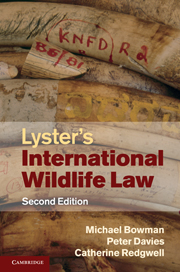Book contents
- Frontmatter
- Contents
- Foreword
- Preface
- List of abbreviations
- PART I Foundations of international wildlife law
- PART II Species regulation
- 5 Fish
- 6 Cetaceans
- 7 Birds
- PART III Regional wildlife regulation
- PART IV Global wildlife regulation
- PART V Biological diversity: a new perspective on wildlife regulation
- PART VI Cross-sectoral issues in wildlife regulation
- PART VII Conclusion
- Index
- References
7 - Birds
Published online by Cambridge University Press: 05 July 2011
- Frontmatter
- Contents
- Foreword
- Preface
- List of abbreviations
- PART I Foundations of international wildlife law
- PART II Species regulation
- 5 Fish
- 6 Cetaceans
- 7 Birds
- PART III Regional wildlife regulation
- PART IV Global wildlife regulation
- PART V Biological diversity: a new perspective on wildlife regulation
- PART VI Cross-sectoral issues in wildlife regulation
- PART VII Conclusion
- Index
- References
Summary
Background
Human recognition of the need to protect birds goes back many centuries, although the underlying motivations have changed significantly over time. Birds were originally valued as a food source, as controllers of insect pests and as sport hunting targets. More recently, emphasis has been placed on their aesthetic and ecological qualities and their importance as ‘indicator’ species which reflect the wellbeing of ecosystems as a whole. Since so many bird species habitually migrate across international boundaries, it is not surprising that international agreements have frequently been concluded to promote their conservation. Another key consideration is that ornithological organisations, which commonly boast a sizeable and articulate membership and command substantial resources and expertise, have played a particularly significant role in the development of international wildlife law.
Although various agreements have been concluded for the benefit of birds specifically, some of these are no longer of much practical importance, greater progress having often been achieved by treaties with a wider operational focus. This chapter begins by examining the instruments which have been adopted within the continent of Europe, followed by those concluded in other regions. It then briefly explains the significance in this context of certain more broadly based conservation agreements, detailed discussion of which can be found elsewhere in this work, before concluding with an analysis of the arrangements adopted specifically for the protection of birds within the framework of the Bonn Migratory Species Convention.
- Type
- Chapter
- Information
- Lyster's International Wildlife Law , pp. 199 - 238Publisher: Cambridge University PressPrint publication year: 2010



